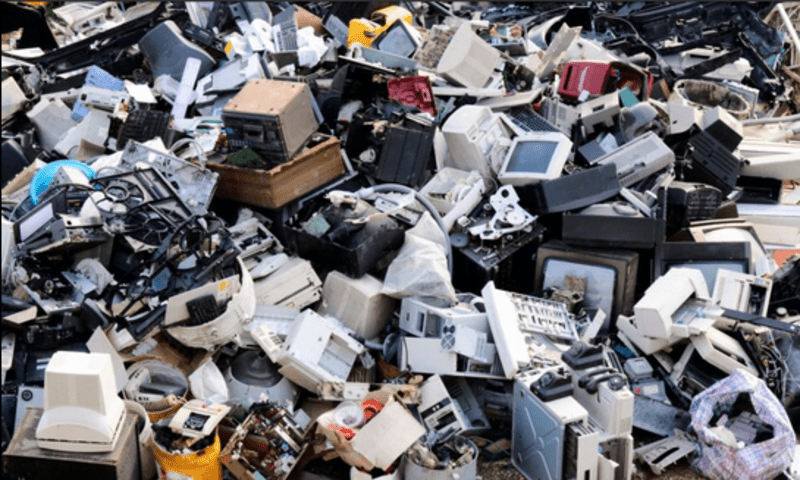GS-3
Context:
Recently,A report and survey conducted by the Indian Cellular and Electronic Association (ICEA) in collaboration with Accenture has revealed that approximately 206 million devices,
including smartphones and laptops, are lying idle in households across India. This accumulation of electronic waste presents several challenges and environmental concerns.
Key Findings of the Report:
- Hoarding of Devices: The report indicates that 40% of respondents are hoarding four or more electronic devices that have remained unused for years.
- Lack of Awareness: Two out of five consumers do not participate in recycling electronic devices.
- Increasing Idle Inventory: In 2021, an additional 75 million devices were added to the growing inventory of idle electronic devices.
About E-Waste:
- Definition: Electronic waste, or e-waste, refers to discarded electronic equipment that is no longer fit for further use due to malfunctioning, lack of repair options, or obsolescence for efficient commercial resale.
- Generation of Global E-Waste:According to the Global E-waste Monitor 2020,the world generated around 54 million metric tons of e-waste in 2019, with projections suggesting a 30% increase by 2030.
- Toxic Emissions: E-waste emits toxic substances like mercury, lead, cadmium, polychlorinated biphenyls, benzene, and dioxins, posing environmental and health risks.
Development of E-Waste Management Regulations in India:
E-waste management in India has evolved through a series of regulations and amendments to address the growing challenge of electronic waste disposal:
- Environment and Forests Hazardous Wastes (Management and Handling) Regulations of 2008: The groundwork for managing electronic waste began with these regulations.
- E-Waste (Management and Handling) Regulations of 2010: In 2011, significant notice was issued regarding these regulations, governed by the Environment (Protection) Act of 1986. The main feature of these regulations was the concept of Extended Producer's Responsibility (EPR).
- E-Waste (Management) Rules, 2016: Enacted in 2017, these rules expanded the scope of e-waste management. They included over 21 products listed in Schedule-I, such as Compact Fluorescent Lamps (CFL) and other equipment containing mercury.
- Amendment in 2018: The rules of 2016 underwent an important amendment, emphasizing the promotion of authorization and product stewardship. Product stewardship involves the responsibility of producers, manufacturers, and other stakeholders throughout a product's entire lifecycle, from its creation to its disposal or recycling.
- E-Waste (Management) Rules, 2022: The Government of India introduced the E-Waste (Management) Rules, 2022, with a primary goal of digitizing the e-waste management process to enhance visibility. These rules also restrict the use of hazardous substances like lead, mercury, and cadmium in the manufacturing of electrical and electronic equipment to prevent adverse impacts on human health and the environment.
- E-Waste Clinics: To handle the segregation, processing, and disposal of household and commercial e-waste, the first e-waste clinic was established in Bhopal.
- Nairobi Declaration 2006: The Nairobi Declaration, adopted at COP 9 of the Basel Convention, aims to control the transboundary movement of hazardous waste.
Challenges in E-Waste Management:
- Health Risks: The mounting volume of e-waste poses health risks, particularly for those working in the informal waste sector. Women working in this sector are exposed to negative birth outcomes, neurological disorders, and DNA damage.
- Illegal Dumping: Despite a ban on e-waste imports, the Ministry of Finance reported 29 cases of illegal e-waste imports in India between 2019-2021.
- Environmental Pollution: Inadequate disposal and recycling of e-waste can result in hazardous materials leaching into the soil and water, contaminating ecosystems and endangering human health and wildlife.
- Rapid Device Replacement: The rapid advancement of technology leads to frequent device replacements, contributing to the growing volume of e-waste as consumers discard still functional but outdated devices.
- Consumer Behavior: A lack of economic incentives, personal attachment to devices, and a lack of awareness can hinder e-waste disposal and recycling efforts.
How can India recycle and reduce E-waste more efficiently?
- Circular Economy: Transitioning from the traditional linear model of "take, make, and dispose" to a circular economy concept that promotes restoration and regeneration can address e-waste issues.
- Right to Repair: Allowing consumers to independently repair and modify their devices, rather than relying solely on manufacturer services, is crucial.
- LiFE (Lifestyle for Environment) Approach: Promoting the repair and reuse of electronic devices, discarding gadgets at e-recycling units, using rechargeable lithium cells, and opting for cloud storage over hard drives can help.
- Extended Producer Responsibility (EPR): EPR, incorporated in the E-Waste (Management) Rules, 2016, stipulates phase-wise collection targets for producers, holding them accountable for e-waste collection and recycling based on previously sold electronic equipment.
- Donation of E-Waste: Encouraging the donation of unused electronic equipment to those in need can yield multiple benefits, such as waste reduction and potential tax deductions for donors.
Conclusion
The accumulation of e-waste in India poses significant challenges, including environmental pollution and health risks. Adopting sustainable solutions, such as a circular economy, the right to repair, and extended producer responsibility, is essential to manage e-waste effectively and mitigate its adverse impacts.



